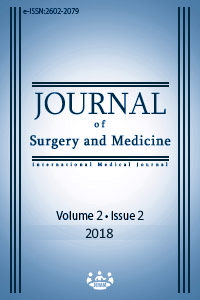Review of 1078 tonsillectomy: Retrospective cohort study
Keywords:
Tonsillectomy, Tonsillectomy hemorrhage, Postoperative infection, Suturation, Local anesthesia, ActinomycesAbstract
Aim: Tonsillectomy is one of the most frequently performed otolaryngologic surgical procedures. We represented our 5 years of experience in tonsillectomy and intended to compare our results with the current literature. We aimed to discuss our tonsillectomy outcomes, mainly giving emphasis on our post tonsillectomy infections and their possible relation with tonsillar pillar suturation, local anesthesia infiltration, comorbidities and presence of Actinomyces colonies in tonsil spesimens.
Methods: This study was carried out retrospectively, in 1078 patients who underwent tonsillectomy operation in between December 2011 and December 2016. The demographic data of the patients, indications for tonsillectomy, suturation if applied, local anesthesia infiltration and its timing, histopathologic findings, co-morbid diseases, postoperative complications and rehospitalizations were recorded. The association of suturation, infiltration of local anesthesia and it’s timing (pre-incisional, post-dissectional), the histopathologic presentation of Actinomyces bacteria in tonsillar spesimens and the presence of accompanying systemic disorders with post- tonsillectomy infections were statistically analysed.
Results: Postoperative infection was seen in 5 (0.5%) patients. Among the suturation group, only 1 (0.5%) patient had infection (p=1). In the infection group 4 (80%) patients had post dissectional local anesthesia infiltration (p=0.574). None of the patients treated with preincisional local anesthesia infiltration, had postoperative infection (p=0.574). In 3 (0.3%) patients, Actinomyces was determined. None of these cases had post-tonsillectomy infections. 142 (13.2%) patients had various co-morbidities associated. Among them, 1 (0.7%) patient had post-operative infection (p=0.507).
Conclusion: According to our results, there is no statistically significant association between suturation of tonsillar pillars, local anesthesia infiltration, comorbidities and presence of Actinomyces and post tonsillectomy infections.
Downloads
References
Colreavy MP, Nanan D, Benamer M, Donnelly M, Blaney AW, O'Dwyer TP, et al. Antibiotic prophylaxis post-tonsillectomy: is it of benefit? Int J Pediatr Otorhinolaryngol. 1999;50:15-22.
Baugh RF, Archer SM, Mitchell RB, Rosenfeld RM, Amin R, Burns JJ, et al. American Academy of Otolaryngology-Head and Neck Surgery Foundation. Clinical practice guideline: tonsillectomy in children. Otolaryngol Head Neck Surg. 2011;144:S1-30.
Seshamani M, Vogtmann E, Gatwood J, Gibson TB, Scanlon D. Prevalence of complications from adult tonsillectomy and impact on health care expenditures. Otolaryngol Head Neck Surg. 2014;150:574-81.
Greaves NS, Ashcroft KJ, Baguneid M, Bayat A. Current understanding of molecular and cellular mechanisms in fibroplasia and angiogenesis during acute wound healing. J Dermatol Sci. 2013;72:206-17.
Orłowski K, Lisowska G, Misiołek H, Paluch Z, Misiołek M. The Efficacy of Perioperative Antibiotic Therapy in Tonsillectomy Patients. Adv Clin Exp Med. 2016;25:493-503.
Sinha UK, Gallagher LA. Effects of steel scalpel, ultrasonic scalpel, CO2 laser, and monopolar and bipolar electrosurgery on wound healing in guinea pig oral mucosa. Laryngoscope. 2003;113:228-36.
Glover JL, Bendick PJ, Link WJ. The use of thermal knives in surgery: electrosurgery, lasers, plasma scalpel. Curr Probl Surg. 1978;15:1-78.
Murthy SM, Goldschmidt RA, Rao LN, Ammirati M, Buchmann T, Scanlon EF. The influence of surgical trauma on experimental metastasis. Cancer. 1989;64(10):2035-44.
Andrea M. Microsurgical bipolar cautery tonsillectomy. Laryngoscope. 1993;103:1177-8.
Carew JF, Ward RF, LaBruna A, Torzilli PA, Schley WS. Effects of scalpel, electrocautery, and CO2 and KTP lasers on wound healing in rat tongues. Laryngoscope. 1998;108:373-80.
Genç E, Hanci D, Ergin NT, Dal T. Can mucosal sealing reduce tonsillectomy pain? Int J Pediatr Otorhinolaryngol. 2006;70:725-30.
Ploegmakers IB, Olde Damink SW, Breukink SO. Alternatives to antibiotics for prevention of surgical infection. Br J Surg. 2017;104:e24-e33.
Naja MZ, El-Rajab M, Kabalan W, Ziade MF, Al-Tannir MA. Pre-incisional infiltration for pediatric tonsillectomy: a randomized double-blind clinical trial.Int J Pediatr Otorhinolaryngol. 2005;69:1333-41.
Grainger J, Saravanappa N. Local anaesthetic for post-tonsillectomy pain: a systematic review and meta-analysis. Clin Otolaryngol. 2008;33:411-9.
Kountakis SE. Effectiveness of perioperative bupivacaine infiltration in tonsillectomy patients. Am J Otolaryngol. 2002;23:76-80.
Ozkiriş M, Kapusuz Z, Saydam L. Comparison of ropivacaine, bupivacaine and lidocaine in the management of post-tonsillectomy pain. Int J Pediatr Otorhinolaryngol. 2012;76:1831-4.
Hobson JC, Malla JV, Kay NJ. Horner's syndrome following tonsillectomy. J Laryngol Otol. 2006;120:800-1.
Shlizerman L, Ashkenazi D. Peripheral facial nerve paralysis after peritonsillar infiltration of bupivacaine: a case report. Am J Otolaryngol. 2005;26:406-7.
Fradis M, Goldsher M, David JB, Podoshin L. Life-threatening deep cervical abscess after infiltration of the tonsillar bed for tonsillectomy. Ear Nose Throat J. 1998;77:418-21.
Allareddy V, Martinez-Schlurmann N, Rampa S, Nalliah RP, Lidsky KB, Allareddy V, et al. Predictors of Complications of Tonsillectomy With or Without Adenoidectomy in Hospitalized Children and Adolescents in the United States, 2001-2010: A Population-Based Study. Clin Pediatr (Phila). 2016;55:593-602.
Guo S, Dipietro LA. Factors affecting wound healing. Dent Res. 2010;89:219-29.
Ekmektzoglou KA, Zografos GC. A concomitant review of the effects of diabetes mellitus and hypothyroidism in wound healing. World J Gastroenterol. 2006;12:2721-9.
Bhargava D, Bhusnurmath B, Sundaram KR, Raman R, Al Okbi HM, Al Abri R, et al. Tonsillaractinomycosis: a clinicopathologicalstudy.Acta Trop. 2001;80:163-8.
Hasan M, Kumar A. Actinomycosis and tonsillar disease. BMJ Case Rep. 2011;12: 2011.
Downloads
- 2267 2564
Published
Issue
Section
How to Cite
License
Copyright (c) 2018 Kübra Çoban, Erdinç Aydın, Serhat İnan, Levent Naci Özlüoğlu
This work is licensed under a Creative Commons Attribution-NonCommercial-NoDerivatives 4.0 International License.















